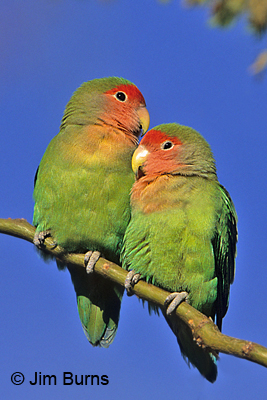
Non-birders and casual birders are fascinated by the lovebirds, listers and environmentalists not so much. This is eye candy that flies and makes noise (I'm reluctant to call their metallic screeches "singing"), so what's not to like? Well, two things, but first let's profile the species.
Peach-faced lovebird, recently renamed rosy-faced lovebird by the International Ornithological Congress, is native to the deserts of southwest Africa where its preferred habitat is savanna--the transition zone between forest and grassland. In this country lovebirds are common cage birds now thriving "in the wild" in Phoenix because a few escaped and found hospitable climate and plentiful food.
In their native land, lovebirds nest colonially using niches in cliff faces or abandoned social weaver nests. In Arizona nests have been found in saguaros, palms, and under roof tiles, and palm fronds are a favored nesting material. Nesting has been observed in April and May, though fledglings have been seen in mid-winter which suggests this species, like other exotics elsewhere, may be taking advantage of the easy living and reproducing throughout the calendar year.
Lovebirds were first reported in Phoenix in 1987, and there are now established colonies all over the east Valley from Cave Creek in the north to Chandler in the south. Their breeding biology partially explains why they have undergone a population explosion in the last decade. Adult plumage is attained at 4 months, they are sexually mature in under a year, and there is evidence they produce two broods per year. The second part of the population equation is that because they are non-indigenous, they have fewer natural predators than in their native savanna.
One thing not to like about the lovebirds, for those keeping birdlists, is that the Arizona Bird Committee has not yet determined them to be "countable." The two major countability criteria for established exotics are "15 years and thriving." It is the latter, the thriving, that has not yet been proven and makes environmentalists a little queasy. Make no mistake, in raw ecological terms this is an invader species pioneering virgin territory. Though it is still too early in the lovebird invasion for any environmental issues to have surfaced, problems with other introduced species such as those with European starlings are all too familiar--competition with our native woodpeckers for saguaro cavities and damage to the health of the saguaros themselves with their droppings. In Africa where colonies of lovebirds gather at rich food sources, damage to grain crops has been well documented.
This is a beautiful but scary little beast. To see it before it either overruns us or dies out, check out 104th and Fenimore in Apache Junction, the Gilbert Water Ranch at Guadalupe and Greenfield, the Arizona Canal north of 40th Street and Camelback, or Doubletree and Tatum in Paradise Valley. Enjoy, but remember there are many unanswered questions about this recent addition to Valley bird life.